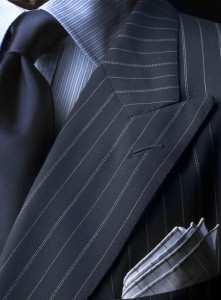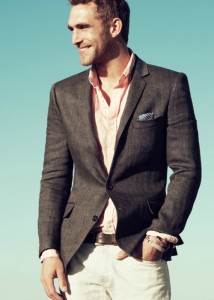 Recently, a reader posed an interesting question that gets to the heart of dressing well: does it matter what you wear when no one is looking?
Recently, a reader posed an interesting question that gets to the heart of dressing well: does it matter what you wear when no one is looking?
This fellow has the benefit of often working from home and his “work” wardrobe rarely strays from tee shirts and shorts, or on a chilly day, some old jeans. For business trips, he does have a dated few suits that do little for him in terms of fit and style.
Though casual by nature, he very much feels that the only way to appear professional in a work setting is by wearing a suit.
While he does not seek to project an overly polished image, our reader is a consultant with a prominent firm and wants to find a more personally authentic way to dress when dressing up. Part of his problem is that like many men, he is afraid of delving into fashion. He sees the donning of a business suit as the only way to project polish, even though his few suits neither fit well nor compliment his build.
Our friend does not know how to modulate his work wardrobe to allow for other more creative – but professional – options that would let him express some personal creativity and professional style.
The Social Contract
 For starters, let’s be clear; a suit is by no means the only “dress up” thing in a man’s wardrobe.
For starters, let’s be clear; a suit is by no means the only “dress up” thing in a man’s wardrobe.
Too often, men see dressing well as a chore; something to avoid or against which they should fight. For some it’s simply a fear of being called a dandy, while for others it is a misguided sense of self-righteousness. This strain of logic asserts that by being sloppy or unconcerned about appearance, they are in fact fighting conformity and not buying into the “suit” thing – you know, being more “real.”
That philosophy usually ascribes that one simply conform to a different model of “conformity.” Dressing like a perpetual college student in order to make a statement is of course its own model of conformity. And, when your professional world is one in which a certain standard of decorum and presentation are expected, you will lose both the battle and the war.
Only today, the Wall Street Journal reported on the continued rise of “formal Fridays,” as the new tool of sartorial rebellion.
However, this does not mean that you must always look like a stuffed shirt to be taken seriously. The world of professional menswear has expanded significantly over the recent years. There is a world of style and personality between flip flops and a three piece suit.
The staff of Details magazine has some very helpful observations about finding a professional personal style.
Rolling out of bed and shuffling down the hall to check the email is not the point here. But, when you step out of the house or log onto a video conference, there is a certain social contract into which we all enter. What you are wearing and how you present yourself now matter. Once you start interacting with other people you ought to show them the same level social and sartorial respect you yourself would expect in return. You should make an effort to dress well because you want to, not because you must.
Being You
 The first rule in dressing well is that you should always be comfortable and true to yourself. The second, and equally important rule, is that whether you like it or not, people judge you by how you dress, how you carry yourself and treat others, your social skills, how you speak, etc.
The first rule in dressing well is that you should always be comfortable and true to yourself. The second, and equally important rule, is that whether you like it or not, people judge you by how you dress, how you carry yourself and treat others, your social skills, how you speak, etc.
Research has repeatedly shown that on average, it takes about eight seconds for someone to decide what kind of person you are based simply on your presentation; and it can take years to alter that initial perception. How you react to this universal truth is ultimately your choice.
Clothing is one our most obvious and influential social, cultural, and style markers. How you choose to dress directly impacts what people think about you and, often, what you think about yourself. And, rethinking your look does not always require radical changes. New jeans in a dark wash in a proper fit or buying some new dress shirts that work with or without a tie take make a huge difference in how the work world sees you.
In our reader’s case, it turns out he does not have to wear only a suit when he travels for business, so we suggested separates, including properly tailored sport coats and several new pair of dress pants. A new blue blazer, several dress shirts that actually fit him, and trim flat-front trousers all made a huge difference in his professional appearance.
Having everything properly sized and tailored costs a bit up front, but consider it a valuable capital investment. Our reader told us that how he sees himself as a person and a professional has changed dramatically and for the better. Just as important; his co-workers have commented on his new polished, professional, and confident personality.

Agree completely with you on your post. My one quibble: Re the guy pictured in the Social Contract section, the button stance on his coat is such that he shows a swath of shirt below the button. Not exactly exemplary style.
Hi, This is a very interesting post! Thanks!